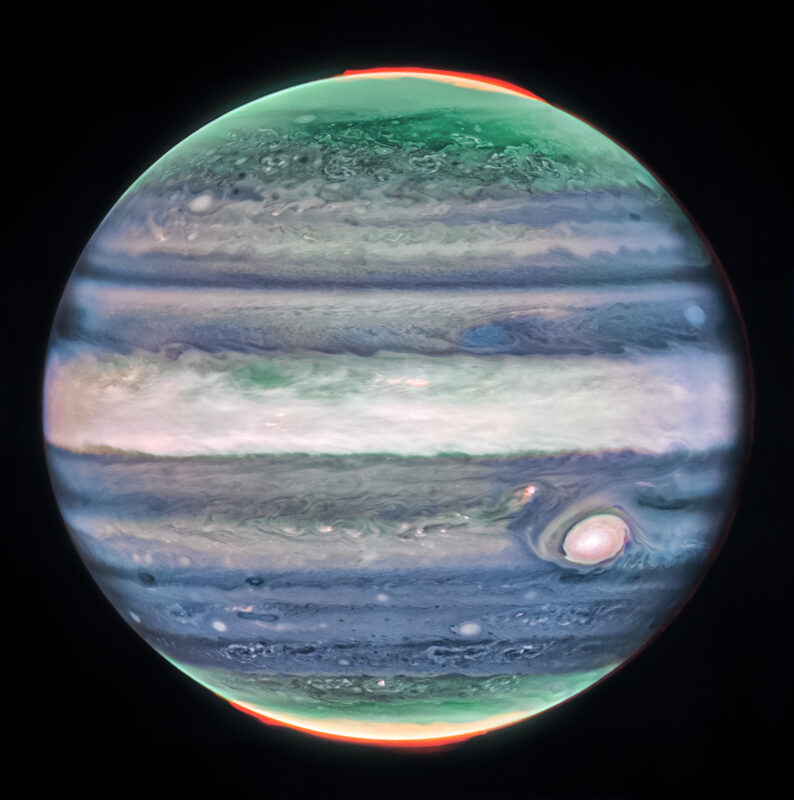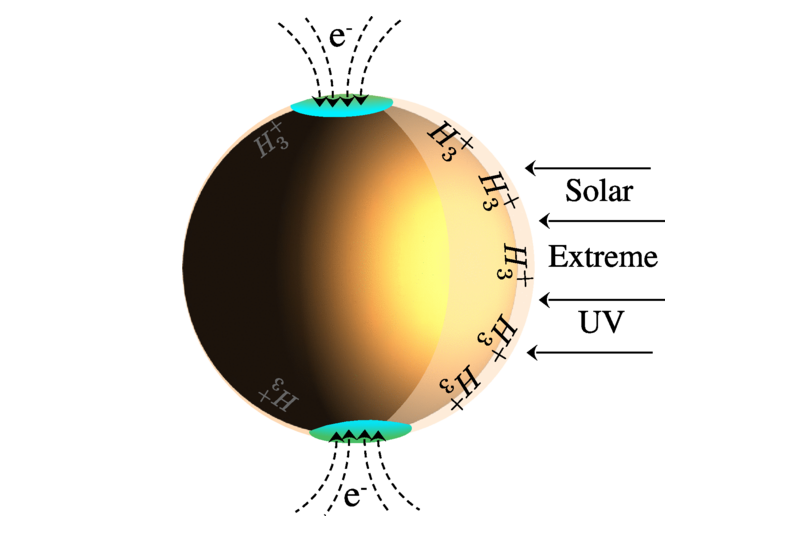Do dark matter collisions on Jupiter glow in the infrared?
Researchers think dark matter collisions make Jupiter's atmosphere glow in infrared light. It would provide another way to detect the mysterious substance.
The post Do dark matter collisions on Jupiter glow in the infrared? first appeared on EarthSky.

Dark matter collisions may show up in the infrared on Jupiter
The dark side of Jupiter at midnight might be aglow with the fallout of dark matter collisions. That’s what a pair of researchers claimed in a paper published June 27, 2024, in the peer-reviewed Physical Review Letters. Dark matter, combined with dark energy, makes up 95% of our universe. But, so far, we haven’t been able to detect dark matter (or dark energy) directly. We can only see its effects. Now comes another dark matter effect, in this case taking the form of an unexplained glow in the atmosphere of Jupiter.
Carlos Blanco of Princeton University in New Jersey and Rebecca Leane of the SLAC National Accelerator Laboratory in California said dark matter particles may be colliding in Jupiter’s atmosphere. If so, the collisions would produce infrared light. Plus, these scientists said, we should see an excess of ions containing three hydrogen nuclei and only two electrons, or trihydrogen cations (H3+). The researchers said:
We apply this search strategy to the night side of Jupiter near the equator. The night side has zero solar irradiation, and low latitudes are sufficiently far from ionizing auroras, leading to a low-background search.
H3+ is the most abundant cation (positive charge) in the universe. Discovered in 1911, it is produced when hydrogen comes under intense pressure. And it’s stable in interstellar space, but breaks down under gravity. Finding it in excess on Jupiter might be a telltale sign of dark matter colliding in the planet’s outer atmosphere.
Using a mission to Saturn to study Jupiter
Blanco and Leane used data gathered during the Cassini-Huygens mission’s flyby of the immense gas giant Jupiter on its way to the ringed world Saturn. During the mission, the Saturn-bound probe used Jupiter’s gravity to accelerate as it flew deeper into the solar system.
The study looked at data from Cassini-Huygens taken three hours on either side of the Jovian dark side’s midnight. The data are from 2000, but Blanco and Leane only recently analyzed them. They were searching for a glow in infrared light. That light could be coming from dark matter colliding with itself after being sucked into Jupiter’s gravity well. The paper stated:
This will be produced if dark matter scatters and is captured by planets, and consequently annihilates, producing ionizing radiation. To produce detectable H3+, the dark matter must produce ionization in the planet’s ionosphere.
The charged particles are then funneled to Jupiter’s poles by its intense magnetic field. The researchers found the signal of dark matter collisions they expected, perhaps giving us another way to detect the elusive substance. And they said the same technique could be used to discover dark matter on Jupiter-like exoplanets.

More studies needed to confirm dark matter collisions
In their paper, Blanco and Leane lay out how H3+ is usually produced and how astronomers detect it using spectroscopy. Some of the interactions that can produce H3+ include cosmic rays, extreme ultraviolet stellar irradiation, planetary lightning or electrons accelerated in planetary magnetic fields. But looking at the Cassini-Huygens data, they found a clear excess of H3+ on Jupiter’s dark side than those sources can produce.
So, is dark matter responsible? The scientists said they’ll need more studies to be entirely certain. The excess could be from an undiscovered source, but Blanco and Leane don’t think so. They said:
We have pointed out and shown for the first time that dark matter can produce ionizing radiation in planetary atmospheres, which is detectable through a smoking-gun excess of atmospheric trihydrogen cations.
Expanding the search beyond Jupiter
If they’re right, then their techniques could lead to detecting dark matter in more exotic locals than the solar system. The paper said:
We also showed that exoplanets in denser dark matter environments such as the inner galaxy could provide even stronger sensitivities to dark matter atmospheric ionization. While an inner-galaxy search would not benefit from low-latitude searches, as auroras would not be able to be distinguished with the resolution of current telescopes, the dark matter ionization rate still can be significantly larger than auroral backgrounds.
And when it comes to exoplanets, the bigger the better. So-called super-Jupiters, with their enormous gravity, would gather and annihilate far more dark matter than puny Jupiter. Such research will require better astronomical instruments. We’ll have to wait for future missions like the Nancy Grace Roman Space Telescope to find out.
Bottom line: Researchers think dark matter collisions make Jupiter’s atmosphere glow in infrared light. If true, it would provide another way to detect the mysterious substance.
Source: Search for Dark Matter Ionization on the Night Side of Jupiter with Cassini
Read more: Did colliding dark matter shape the El Gordo galaxy cluster?
Read more: Can we detect dark matter using light from pulsars?
The post Do dark matter collisions on Jupiter glow in the infrared? first appeared on EarthSky.
